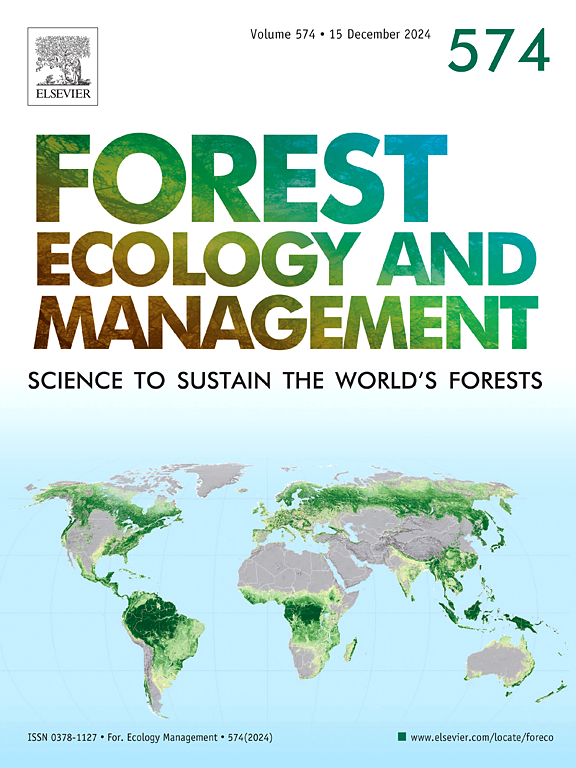Site-specific growth-climate relationships of a widespread coniferous species across mountain areas
IF 3.7
2区 农林科学
Q1 FORESTRY
引用次数: 0
Abstract
The prevailing framework for evaluating the ecological responses of a species to climate change assumes the future conditions can be predicted based on spatial variations of this species' performance along climatic gradients. However, such growth-climate relationships for trees may be complicated in high-elevation mountain regions with rugged terrain, especially in semi-arid areas. Here, we investigated the climate sensitivity of a keystone subalpine coniferous species, Qinghai spruce (Picea crassifolia Kom.), using ten standard tree-ring width chronologies (STD) along the temperature and precipitation gradients of the Qilian Mountains. Based on their hydrothermal conditions, the ten sampling sites were classified into two climatic clusters. In warmer and drier conditions (Cluster 1), STD correlated with summer mean temperature negatively, but showed a significant positive correlation with summer precipitation, suggesting trees experienced significant drought stress. The relationships were the opposite at the sites with cooler and moister conditions (Cluster 2) that temperature acted as a limiting factor for tree growth. As the distribution of sites from the two clusters overlapped, the climate sensitivity of Qinghai spruce did not align with the northwest-southeast temperature and meridional precipitation gradients that were widely employed in previous studies. Our results highlight the importance of local climate effects on trees’ responses to climate changes, offering an alternative approach to assess the growth-climate response pattern in mountain forests and warranting the use of the space-for-time substitution in studies of climate change ecology.
一种广泛分布于山区的针叶林物种的特定地点生长-气候关系
评估物种对气候变化的生态响应的主流框架假设,未来的条件可以根据该物种在气候梯度上的表现的空间变化来预测。然而,在地形崎岖的高海拔山区,特别是半干旱地区,树木的这种生长-气候关系可能会变得复杂。利用10种标准树木年轮宽度年表(STD)研究了青海云杉(Picea crassifolia Kom.)亚高山针叶林的气候敏感性。根据其热液条件,将10个采样点划分为两个气候群。在暖干条件下(聚类1),STD与夏季平均温度呈负相关,与夏季降水呈显著正相关,表明树木经历了显著的干旱胁迫。在较冷和较湿的条件下(集群2),温度是树木生长的限制因素,这种关系相反。由于两个类群的站点分布重叠,青海云杉的气候敏感性与以往研究中广泛采用的西北-东南温度和经向降水梯度不一致。我们的研究结果强调了局部气候效应对树木对气候变化的响应的重要性,为评估山地森林生长-气候响应模式提供了另一种方法,并保证了在气候变化生态学研究中使用空间-时间替代。
本文章由计算机程序翻译,如有差异,请以英文原文为准。
求助全文
约1分钟内获得全文
求助全文
来源期刊

Forest Ecology and Management
农林科学-林学
CiteScore
7.50
自引率
10.80%
发文量
665
审稿时长
39 days
期刊介绍:
Forest Ecology and Management publishes scientific articles linking forest ecology with forest management, focusing on the application of biological, ecological and social knowledge to the management and conservation of plantations and natural forests. The scope of the journal includes all forest ecosystems of the world.
A peer-review process ensures the quality and international interest of the manuscripts accepted for publication. The journal encourages communication between scientists in disparate fields who share a common interest in ecology and forest management, bridging the gap between research workers and forest managers.
We encourage submission of papers that will have the strongest interest and value to the Journal''s international readership. Some key features of papers with strong interest include:
1. Clear connections between the ecology and management of forests;
2. Novel ideas or approaches to important challenges in forest ecology and management;
3. Studies that address a population of interest beyond the scale of single research sites, Three key points in the design of forest experiments, Forest Ecology and Management 255 (2008) 2022-2023);
4. Review Articles on timely, important topics. Authors are welcome to contact one of the editors to discuss the suitability of a potential review manuscript.
The Journal encourages proposals for special issues examining important areas of forest ecology and management. Potential guest editors should contact any of the Editors to begin discussions about topics, potential papers, and other details.
 求助内容:
求助内容: 应助结果提醒方式:
应助结果提醒方式:


